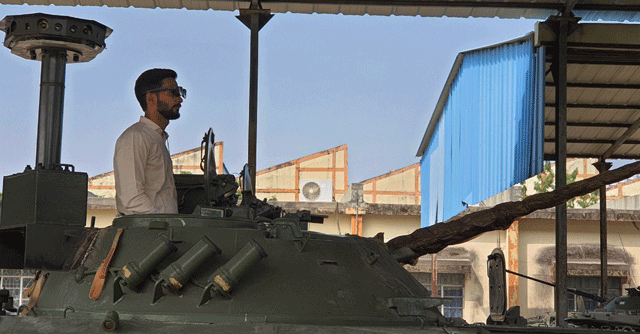
India's armed forces enlist startups to help train pilots, repair aircraft with AR, VR


The use of augmented reality (AR) and virtual reality (VR) based solutions for training aircraft pilots, repairing aircraft, increasing weapon efficiency and even making tanks more resilient on the battlefield is moving from proof of concept to the application stage.
A see-through armour system developed by Mumbai-based AR/VR startup AjnaLens, which raised Rs 12 crore in a pre-series A funding last month, is a case in point. Christened AjnaESAS (enhanced situational awareness system), the system comprises an AR-based head-mounted display and a 360-degree camera to allow the crew inside a tank to have a 360-degree horizontal field of view from inside. The camera system also provides night vision and 4X zoom capabilities.
“One of the limitations of tanks is visual awareness in terms of what is around the tank as they have to navigate through a small periscopic view, which makes navigation difficult,” said Abhishek Tomar, co-founder, and chief technology officer, AjnaLens. “The AR-based solution can empower drivers to safely navigate through dust, sand, and haze. This increases the survivability of the crew,” added Tomar who says his company's clients include the Indian Army, Indian Navy, and the Defence Research and Development Organisation (DRDO).

According to Pankaj Raut, co-founder, and chief executive of the firm, the Indian army was looking for a solution that would allow a person inside the tank to see through its armoured body. The company created a prototype that received a grant of Rs 1.5 crore from the Ministry of Defence under the iDEX initiative for further development. “While the project is near completion and user test trials are successfully finished, the final field trials are yet to conclude. The timeline for deployment is yet to be decided,” said Raut.
Electronic systems such as these can also be hacked if connected to a network during battle, which explains why the entire system is kept offline and accessible only to the crew of the tank, the company said. The camera feed is generated and fed directly into the AR headset in real-time.
There are other companies besides AjnaLens that are experimenting with the use of AR and VR in the Indian defence sector. Krupalu Mehta, co-founder, and chief executive of Mumbai-based Parallax Labs, corroborated that a lot of defence agencies have been doing proof of concepts and demos. Some of these solutions are now getting deployed, even though the scale of implementation is still very small.

Training to fly an aircraft, use weapons etc is among the potential growth areas in the defence sector where these AR/VR startups are seeing traction. For instance, Parallax has developed a VR-based personal flight simulator that presents a more cost-effective alternative to traditional flight simulators.
Parallax, on its part, deployed one of its VR simulators at a Naval aviation unit in Goa in October 2021 and is in talks to deploy one at the Combat Army Aviation Training School in Nashik. “Traditional simulators have a lot of hardware dependencies, including motion platforms, curved screens — all of which take up a lot of physical space. For training on a different aircraft, cockpit hardware has to be changed all the time. Training on a full flight simulator costs Rs. 1 lakh per hour. An even bigger problem is that multiple arms of defence rely on a single aircraft simulator in the Western Command in Bengaluru.
Parallax is currently using its VR solution for training on HAL’s ALH Mk-III helicopters. “Setting up a VR simulator can cost Rs.15-20 lakh. It can allow defence forces to install multiple simulators within their units. It also provides the option to have multiple aircraft and allow two pilots to collaborate on a single mission in training,” he added.

Training engineers for the repair and maintenance of aircraft is another area where VR solutions are making headway. Mehta points out, every year, the government spends Rs 800-900 crore on the maintenance of aircraft. For an aircraft like Sukhoi, one hour of flying requires five hours of maintenance. The operators need to be trained on maintenance and knowing the entire aircraft. VR solutions provide a view of the entire aircraft and helps discover faults faster. “We have also incorporated artificial intelligence (AI) to understand and pick up various faults and create randomized scenarios for trainees that can be put in the training module,” said Mehta. The training module is under development and will be up and running sometime in the second half of the year.
Apart from training, these technologies are also being used to enhance vision to engage with targets during combat. AjnaLens has an AR-based guiding system that can upgrade MANPAD (man-portable air defence system), which is used in portable surface-to-air missiles. These AR-based glasses are directly connected to the radar and the information relayed by them is converted into holographic images to provide an early warning on where and how far the target is, regardless of the weather conditions. According to Tomar, Most of the weapons used in India are fair weather and not all weather. Misfirings on MANPADs can be expensive. One round can cost Rs 3-4 lakh. Tomar said his startup is hoping to deploy 500 to 600 of these AR systems this year if it bags the government tender for it.
Elsewhere, in June 2021, Switzerland’s Department of Defense had commissioned a VR simulator for training. Mehta explains, getting a simulator commissioned means training on it will be counted as part of the official training hours. He expects India to commission VR simulators this year or next. In the US, Microsoft was contracted by the US Army to supply 120,000 Integrated Visual Augmentation Systems (IVAS) headsets, based on Microsoft's HoloLens. The timeline for testing and deployment has been pushed to the end of this year.

